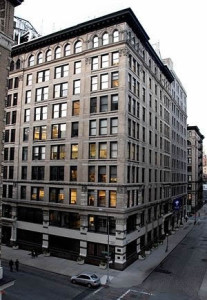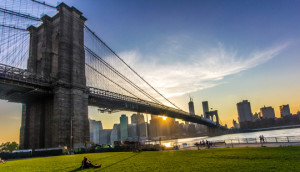Labor Day commemorates the history of the labor movement and the social and economic gains of workers in the United States. New York City has been a location for many significant milestones of labor history. We here at CityLand document the changes in New York City land use, but we would be remiss to ignore that behind every land use change is the hard labor of American workers, from demolition to construction and all points in between. These men and women in the labor community have helped shaped New York’s majestic skyline. In celebration of the holiday, we have created a list of historic places that have a connection to the labor community. Some of these site have even been designated by the Landmarks Preservation Commission. From all of us here at the Center for New York City Law, have a happy Labor Day!
Location: Manhattan from 14th Street to 18th Street, between 5th Avenue and Irving Place
Date: 1832
In 1882, Union Square was the site of New York’s first Labor Day parade, where the Knights of Labor led 25,000 people in a march for legislation establishing an eight-hour workday and a ban on child labor. In 1930, a demonstration of 35,000 people protesting the Great Depression ended in violence with the police, injuring 100. In 1925, Amalgamated Bank – the first union-owned bank in New York City – established their first headquarters at 15 Union Square where it remained until 2006.
Location: 914 – 1000 Richmond Terrace, Staten Island
Date: 1831
LPC Designated: October 14, 1965, expanded on November 15, 1967 and May 15, 1973
Sailors Snug Harbor was the first retirement home in America for retired and disabled merchant sailors. Prior to opening, sailors could only turn to family or churches for support. Captain Robert Richard Randall, a Revolutionary War veteran, originally left his country estate in Manhattan for this purpose upon his death in 1801. The estate was adjacent to present-day Washington Square and was bounded by 5th Avenue to the west, Broadway to the east, 10th Street to the north, and 8th Street to the south. However, Randall’s heirs challenged the will for decades and by the time the dispute was settled, the Manhattan estate had been developed. The decision was made by Snug Harbor’s trustees to establish the retirement home on another of Randall’s properties on Staten Island, where it sits today.

The Brown Building, former location of the Triangle Shirtwaist Factory. Image credit: U.S. Department of Labor
Location: 23-29 Washington Place, Manhattan
Date: 1901
LPC Designated: March 25, 2003
The Triangle Shirtwaist Factory was located on the top three floors in what was known as the Asch Building and is now known as the Brown Building. On March 25, 1911, a fire broke out on the eighth floor and quickly spread throughout the factory, predominantly staffed by Jewish and Italian immigrant women. By the time the fire was put out, 146 of the 500-person workforce had died: 123 women and 23 men. The death toll was attributed to a poorly-constructed fire escape on the building exterior, and an internal exit having been locked on the orders of the factory owners to prevent the workers from stealing. In the aftermath of the fire, the New York State Legislature created the Factory Investigating Commission to evaluate working conditions in all of New York State’s factories. Building and fire codes were overhauled, and new labor laws were established limiting the number of hours that women and children could work. The Brown Building is today part of the NYU campus, but still features a plaque from the International Ladies’ Garment Workers Union commemorating the fire.
Brotherhood of Sleeping Car Porters Headquarters
Location: 217 West 125th Street, Harlem, Manhattan
Date: August 25, 1925
Founded by A. Philip Randolph in Harlem on August 25, 1925, the Brotherhood of Sleeping Car Porters was the first African-American-led labor organization to receive a charter with the American Federation of Labor. The Brotherhood spent the next ten years fighting a hostile racial climate for recognition and the anti-union Pullman Company for a collective bargaining agreement, both of which they achieved by 1937. The Brotherhood went on to play a strong role in the Civil Rights Movement throughout the mid 20th Century, until their merger with the Brotherhood of Railway and Airline Clerks in 1978.
Location: Robert F. Wagner Houses, East Harlem, Manhattan
Date: May 31, 1958
Robert F. Wagner was one of New York’s United States Senators from 1927 to 1949. A graduate of New York Law School, Senator Wagner worked closely with President Franklin D. Roosevelt in creating the New Deal. Senator Wagner authored the National Labor Relations Act (also known as the “Wagner Act”), which established the National Labor Relations Board and guaranteed unions the right to bargain collectively with employers on behalf of their members. Senator Wagner was a principal author of the Social Security Act, which created the Social Security pension program, introducing the Act into the U.S. Senate in 1935. Prior to his first term in the Senate, Wagner served in both the New York State Assembly and Senate, and chaired the Factory Investigating Commission formed after the Triangle Shirtwaist Fire.
Location: 71-11 112th Street, Forest Hills, Queens
Date: 1917
While popularized for overcoming deafness and blindness, Helen Keller was also an active social campaigner, world-renowned for her efforts in advancing worker’s rights and women’s suffrage in the early 20th century. While serving on a commission investigating conditions for the blind, Keller realized that many cases of blindness in America were not from birth but attributable to industrial accidents caused by poor safety conditions. Keller joined the International Workers of the World in 1912, and helped found the American Civil Liberties Union in 1920. The site, originally 93 Seminole Avenue, is the present-day location of the Reform Temple of Forest Hills.

The Brooklyn Bridge, seen from the Brooklyn side of the East River. Image credit: New York Public Library
Location: East River between Manhattan and Downtown Brooklyn
Date: 1883
LPC Designated: August 24, 1967
Laborers Local 147, better known as “the Sandhogs”, traces its beginning to the Brooklyn Bridge. During construction, 200 laborers went on strike on May 8, 1872. During two years of working underground, excavating mud and boulders for the bridge’s foundations, many of the workers had contracted compression sickness. The afflicted workers suffered severe pain in their joints, paralysis, and in some cases, death. The strike was settled for a fifty-cent wage raise from $2.25 to $2.75 per day, but marked the beginning of the sandhogs’ organization. Local 147 was formally established in 1906, and the sandhogs would go on to build the tunnels for New York City’s subway, sewer, and water supply systems, as well as the Lincoln, Holland, Queens Midtown, and Brooklyn-Battery Tunnels.
By: Brian Kaszuba, CityLand Editor and Michael Twomey, CityLand Fellow.



